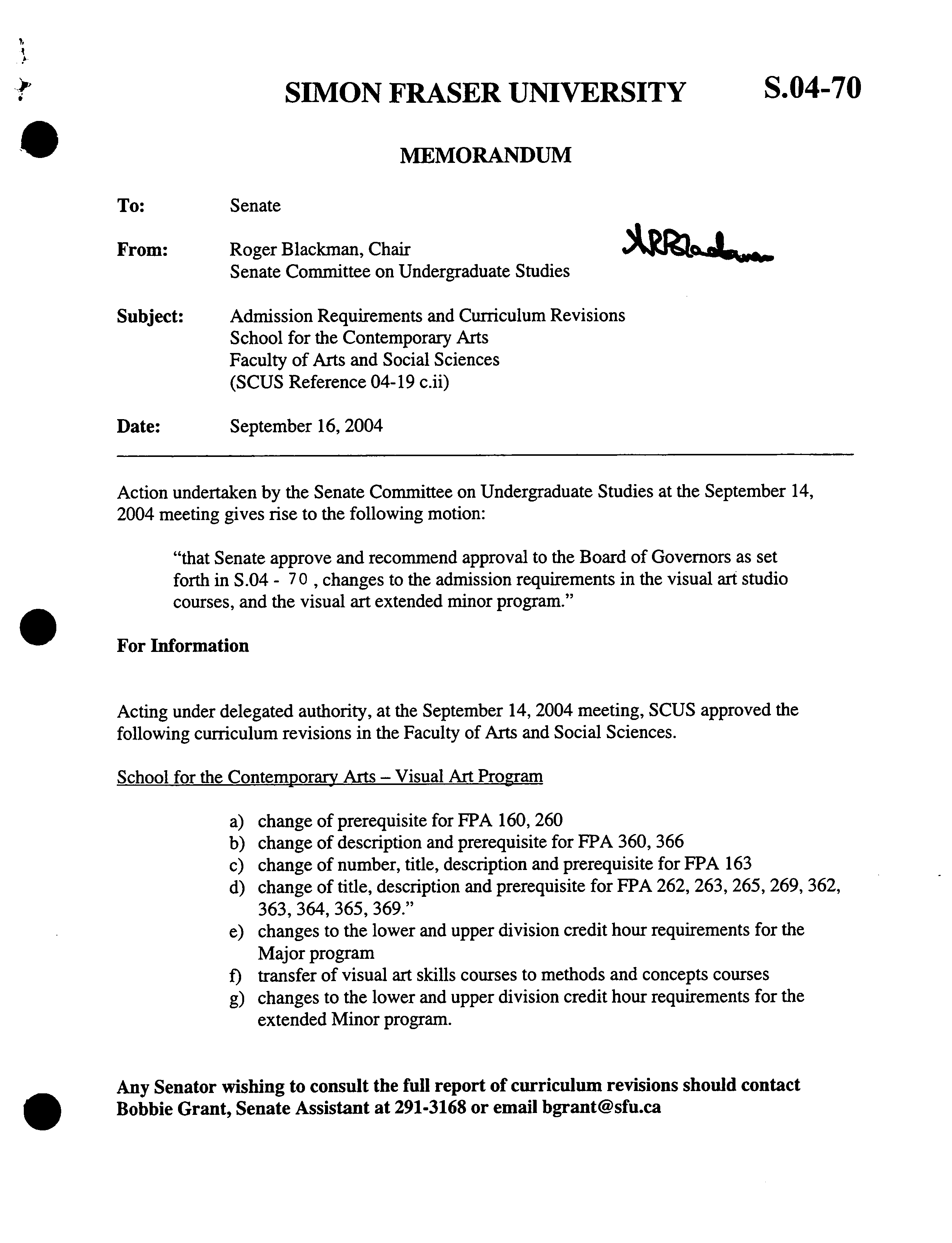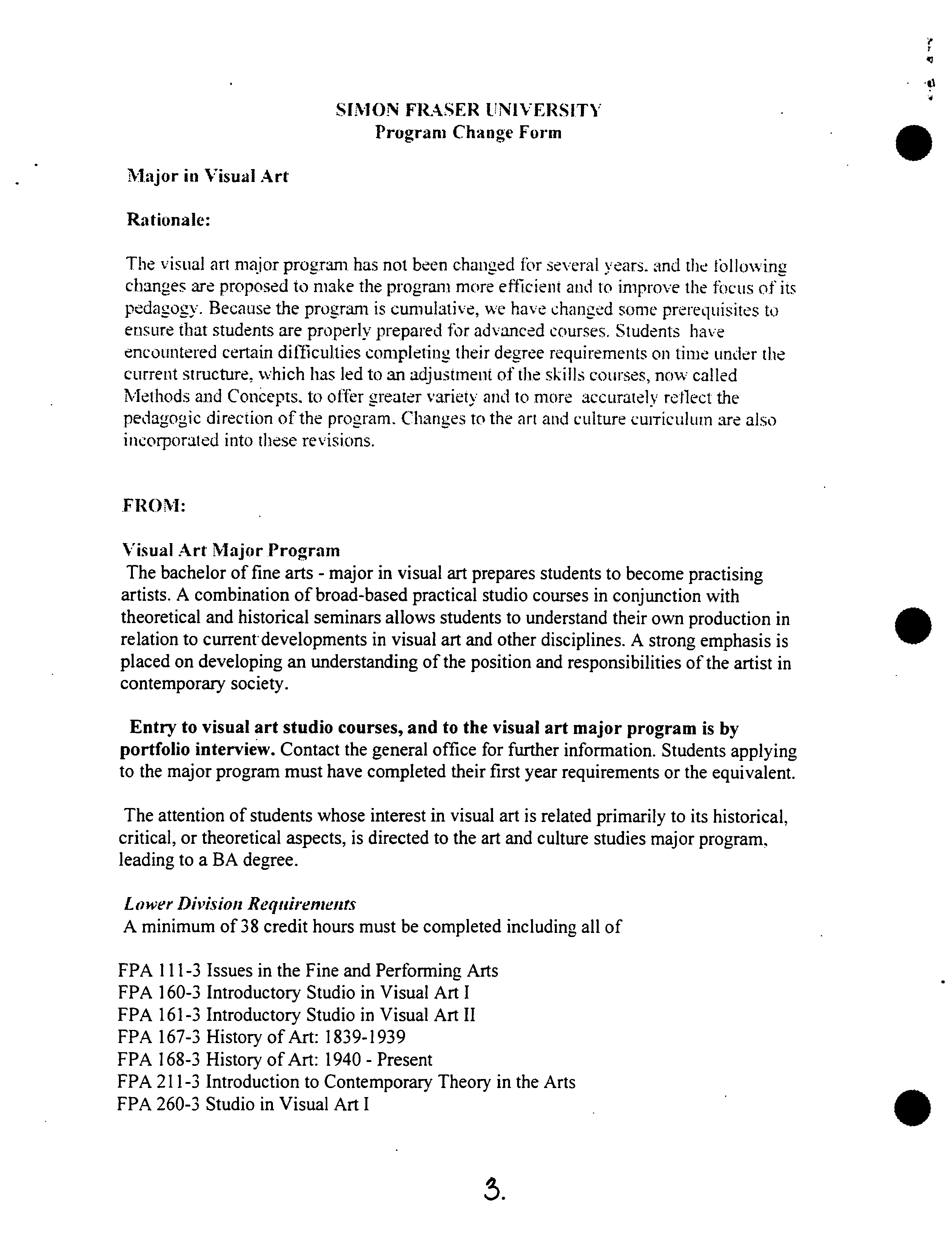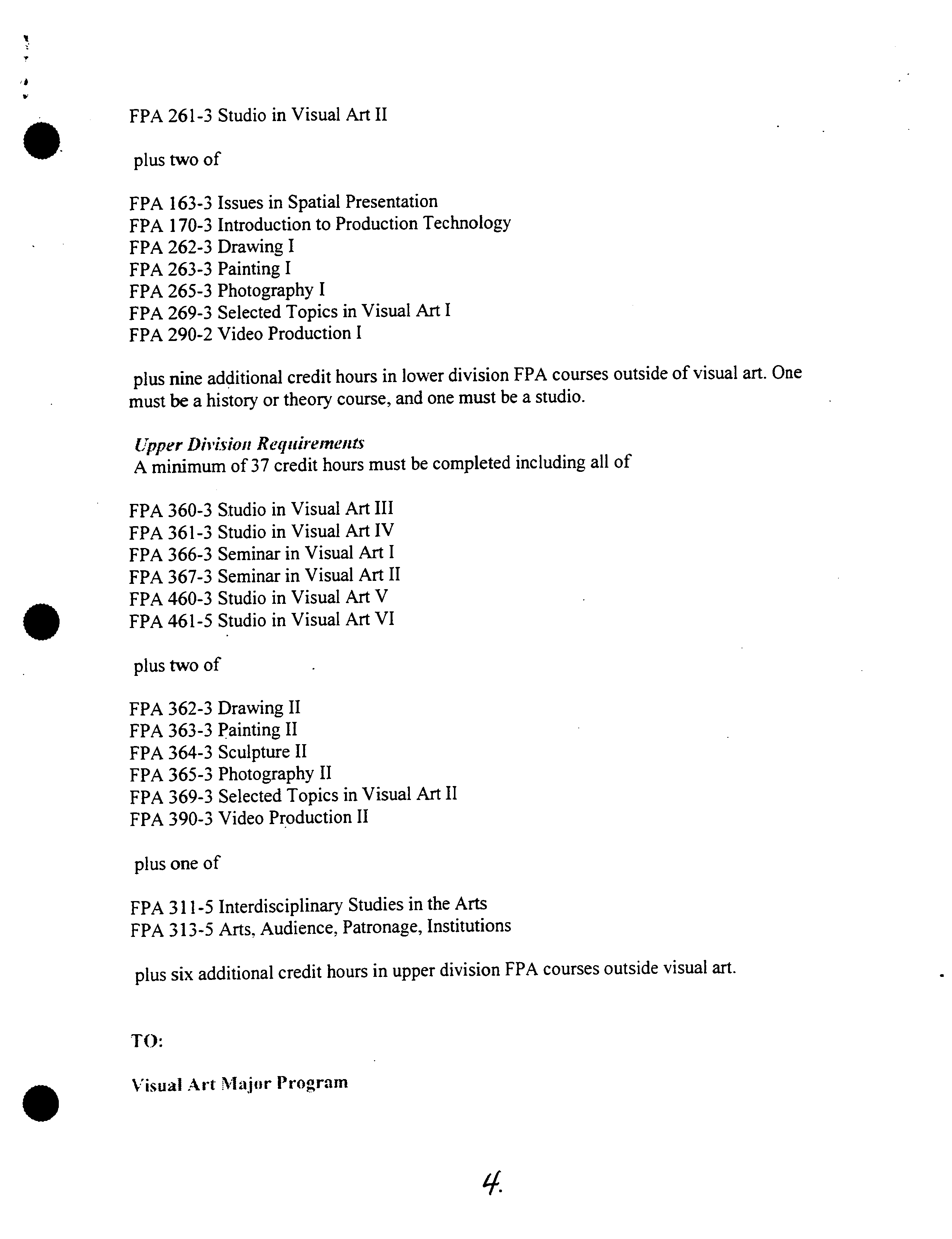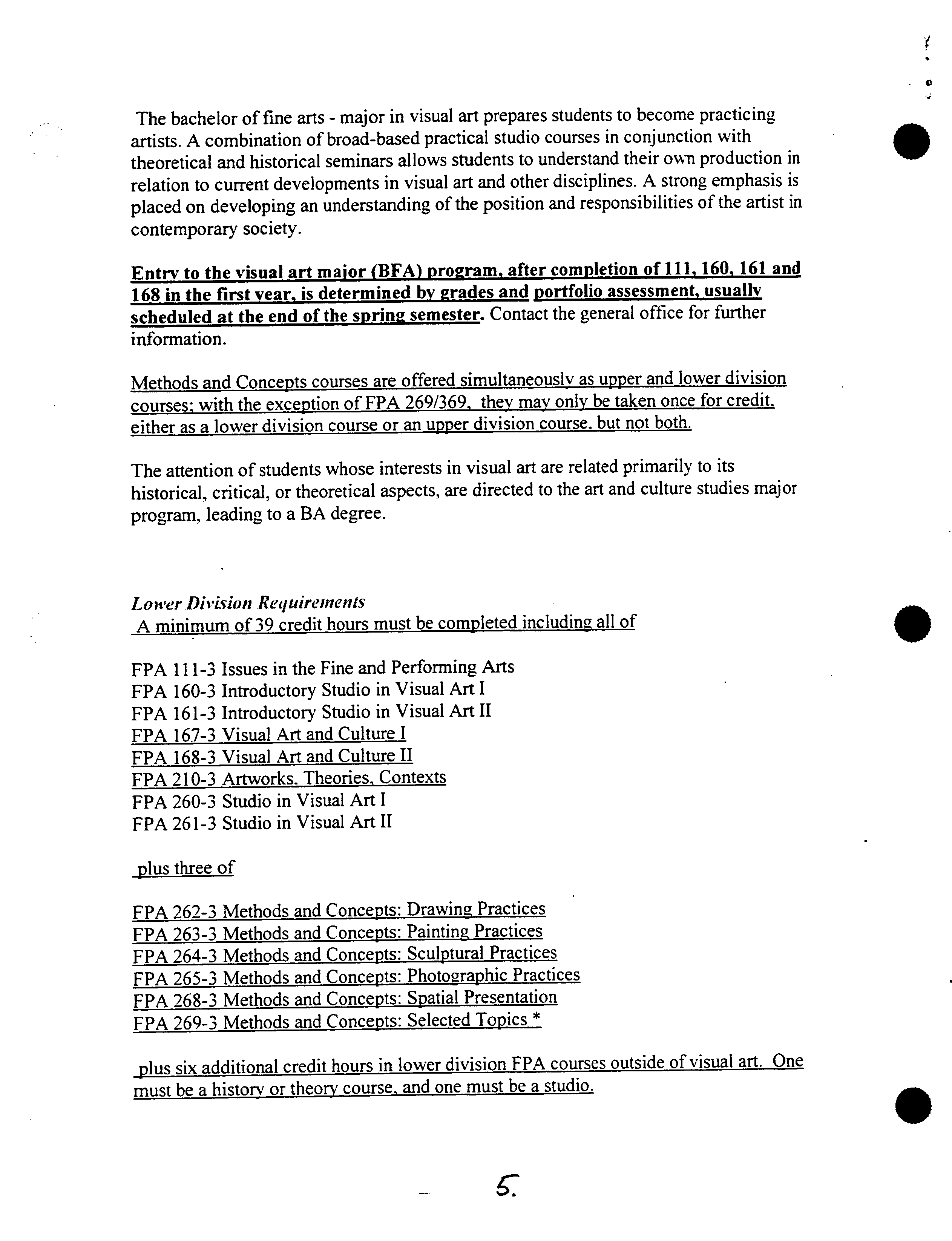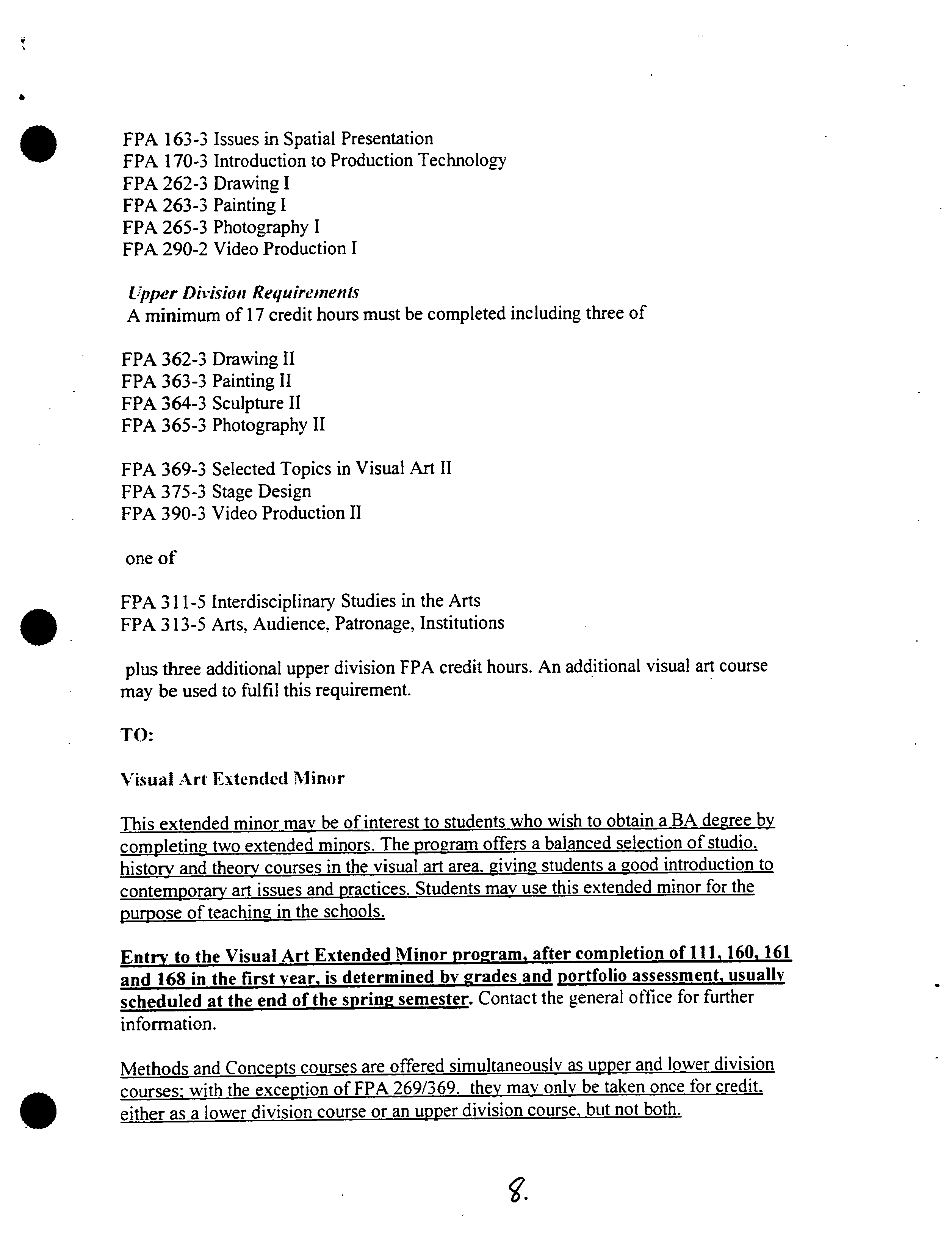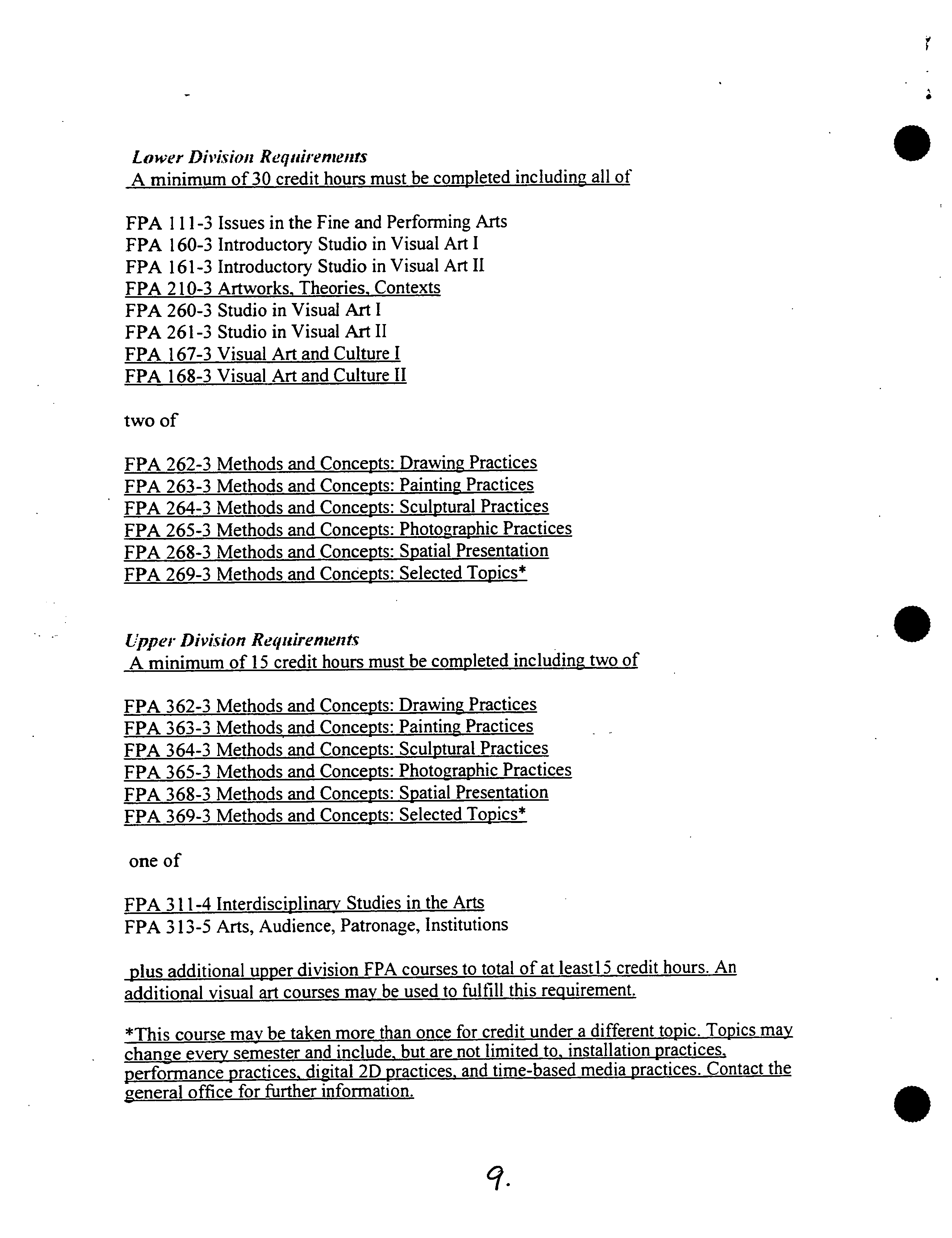SIMON FRASER UNIVERSITY ?
S.04-70
0
?
MEMORANDUM
To: ?
Senate
From: ?
Roger
Senate
Blackman,
Committee
Chair
on Undergraduate
?
Studies
*RZOIJL^
Subject:
?
?
Admission Requirements and Curriculum Revisions
School for the Contemporary Arts
Faculty of Arts and Social Sciences
(SCUS Reference 04-19 c.ii)
Date: ?
September 16, 2004
Action undertaken by the Senate Committee on Undergraduate Studies at the September 14,
2004 meeting gives rise to the following motion:
"that Senate approve and recommend approval to the Board of Governors as set
forth in S.04 - 70 , changes to the admission requirements in the visual art studio
•
?
courses, and the visual art extended minor program."
For Information
Acting under delegated authority, at the September 14, 2004 meeting, SCUS approved the
following curriculum revisions in the Faculty of Arts and Social Sciences.
School for the Contemporar
y
Arts - Visual Art Program
a)
change of prerequisite for FPA 160, 260
b)
change of description and prerequisite for FPA 360, 366
c)
change of number, title, description and prerequisite for FPA 163
d)
change of title, description and prerequisite for FPA 262, 263, 265, 269, 362,
363,364,
365,
369."
e)
changes to the lower and upper division credit hour requirements for the
Major program
f)
transfer of visual art skills courses to methods and concepts courses
g)
changes to the lower and upper division credit hour requirements for the
extended Minor program.
Any
Senator wishing to consult the full report of curriculum revisions should contact
Bobbie Grant, Senate Assistant at 291-3168 or email bgrant@sfu.ca
.>
S ?
EXTENDED RATIONALE:
CHANGING VISUAL ART SKILLS COURSES TO METHODS AND
CONCEPTS COURSES
For some time, the Visual Art area has had scheduling difficulties in offering the required
skills courses necessary to complete both the Extended Minor and the BFA major. Lack
of teaching support has meant putting these courses into three and four-semester rotation,
making it awkward for students (especially in the Extended Minor) to complete the
required 4 or 6 courses in the time allocated for the completion of their degree.
A second problem has been the limited range of available offerings. The pedagogic
mandate of the program, which is to prepare students for a shifting environment of
contemporary artistic practices, has been compromised by this lack of breadth. It has also
meant that core faculty are not able to teach inside their areas of expertise.
To alleviate these concerns, the area is proposing to eliminate the present 2-course-per-
skill model (one upper and one lower) by collapsing the two together and changing the
emphasis of the resultant course to a broad-ranging introduction to all aspects of the
given skill, as it pertains to actual contemporary art practice. This serves several
functions: it gives students a one-semester introduction to an art practice which can then
be taken directly into the core studio courses for further development; it allows the new
S ?
offerings to be taken either as upper or lower division courses, depending on the student's
requirements, and it effectively doubles the number of available skills courses while
allowing for more regularized offerings and expedient degree completions.
A second benefit of this reduction is that it allows the existing Selected Topics courses
(FPA 269/369) to be used in the same manner, to introduce a repeating range of topics
currently unavailable to the students but which are crucial topics for work in
contemporary art; these include time-based media, installation practices, performance
work and computer-based processes. This will also corresponds more closely to the
actual research capacities of the current faculty, allowing them to do direct teaching in
the areas of their research and expertise.
Under the current model, we are able to offer 2 or
3
skills courses a semester, which will
continue under the proposed model: typically this means
5
courses a year. Now, however,
students may choose from a possible range of 8 or 9 different topics within a 2-year
cycle, whereas previously they had 4 or 5 in a 3 to 4 year rotation.
In conjunction with this change, we are proposing to reduce the current 6 skills-course
requirement in the Extended Minor to 4, allowing for more expedient degree completion.
This proposal does not entail adding new courses. Using existing numbers with new
course descriptions, it improves the range of course offerings and strengthens pedagogy
in the area, eases degree completion, and allows faculty to teach what they know.
c2.
•11
SIMoN FRASER UNIVERSITY ?
Program Change Form
Major in Visual Art
Rationale:
The visual art major program has not been changed ibr several years. and the Ibilowing
changes are proposed to make the program more efficient and to improve the focus of its
pedagogy. Because the program is cumulative, we have changed some prerequisites to
ensure that students are properly prepared for advanced courses. Students have
encountered certain difficulties completin
g their degree requirements on time under the
current structure, which has led to an adjustment of the skills courses,
now called
Methods and Concepts. to offer greater variety and to more accuratel
y reflect the
pedagogic direction of the program. Changes to the art and culture culTiculum are also
incorporated into these revisions.
.FR(.)
M:
Visual Art Major Program
The bachelor of fine arts - major in visual art prepares students to become practising
artists. A combination of broad-based practical studio courses in conjunction with
theoretical and historical seminars allows students to understand their own production in
relation to current developments in visual art and other disciplines. A strong emphasis is
placed on developing an understanding of the position and responsibilities of the artist in
contemporary society.
Entry to visual art studio courses, and to the visual art major program is by
portfolio interview.
Contact the general office for further information. Students applying
to the major program must have completed their first year requirements or the equivalent.
The attention of students whose interest in visual art is related primarily to its historical,
critical, or theoretical aspects, is directed to the art and culture studies major program,
leading to a BA degree.
Lower Division Requirements
A minimum of
-3 8
credit hours must be completed including all of
FPA 111-3 Issues in the Fine and Performing Arts
FPA 160-3 Introductory Studio in Visual Art I
FPA
161-3
Introductory Studio in Visual Art II
FPA
167-3
History of Art: 1839-1939
FPA 168-3 History of Art: 1940- Present
FPA
211-3
Introduction to Contemporary Theory in the Arts
FPA 260-3 Studio in Visual Art I
3.
S
FPA 26 1-3 Studio in Visual Art II
plus two of
FPA
163-3
Issues in Spatial Presentation
FPA 170-3 Introduction to Production Technology
FPA 262-3 Drawing I
FPA 263-3 Painting I
FPA
265-3
Photography I
FPA 269-3 Selected Topics in Visual Art I
FPA 290-2 Video Production I
plus nine additional credit hours in lower division FPA courses outside of visual art. One
must be a history or theory course, and one must be a studio.
(ippr Dlvi sio,z Requirements
A minimum of 37 credit hours must be completed including all of
FPA 360-3 Studio in Visual Art III
FPA 361
-3 Studio in Visual Art IV
FPA 366-3 Seminar in Visual Art I
FPA 367-3 Seminar in Visual Art II
FPA 460-3 Studio in Visual Art V
FPA 461-5 Studio in Visual Art VI
•
plus two of
FPA 362-3 Drawing II
FPA 363-3 Painting II
FPA 364-3 Sculpture II
FPA 365-3 Photography II
FPA 369-3 Selected Topics in Visual Art II
FPA 390-3 Video Production II
plus one of
FPA 311-5 Interdisciplinary Studies in the Arts
FPA 313-5 Arts, Audience, Patronage, Institutions
plus six additional credit hours in upper division FPA courses outside visual art.
Visual Art Major Program
0
?
.
4.
The bachelor of fine arts - major in visual art prepares students to become practicing
artists. A combination of broad-based practical studio courses in conjunction with
theoretical and historical seminars allows students to understand their own production in
relation to current developments in visual art and other disciplines. A strong emphasis is
placed on developing an understanding of the position and responsibilities of the artist in
contemporary society.
Entr y
to the visual art major (BFA) pro
gram,
after completion of 111. 160, 161 and
168 in the first
y
ear, is determined b
y
grades and portfolio assessment, usually
scheduled at the end of the sprin
g
semester.
Contact the general office for further
information.
Methods and Conce pts
courses are offered simultaneously as upper and lower division
courses: with the exception of FPA 269/369, the
y
may onl y
be taken once for credit.
either as a lower division course or an upper division course. but not both.
The attention of students whose interests in visual art are related primarily to its
historical, critical, or theoretical aspects, are directed to the art and culture studies major
program, leading to a BA degree.
Loner DivLsion RequireinenLs
A minimum of 39 credit hours must be completed including all of
FPA 111-3 Issues in the Fine and Performing Arts
FPA 160-3 Introductory Studio in Visual Art I
FPA 161-3 Introductory Studio in Visual Art II
FPA 167-3 Visual Art and Culture I
FPA 168-3 Visual Art and Culture II
FPA 210-3 Artworks. Theories, Contexts
FPA 260-3 Studio in Visual Art I
FPA 261-3 Studio in Visual Art II
plus three of
FPA 262-3 Methods and Concepts: Drawing Practices
FPA 263-3 Methods and Concepts: Painting Practices
FPA 264-3 Methods and Concepts: Sculptural Practices
FPA
265-3
Methods and Concepts: Photographic Practices
FPA 268-3 Methods and Concepts: S
patial
Presentation
FPA 269-3 Methods and Concepts: Selected Topics *
jplus six additional credit hours in lower division FPA courses outside of visual art. One
must be a histor
y
or theory course, and one must be a studio.
?
0
Upper Division Requirements
A minimum of 36 credit hours must be completed including all of
FPA
360-3
Studio in Visual Art III
FPA 361 -3 Studio in Visual Art IV
FPA 366-3 Seminar in Visual Art I
FPA 367-3 Seminar in Visual Art II
FPA 460-3 Studio in Visual Art V
FPA 461-5 Studio in Visual Art VI
plus two of
FPA 362-3 Methods and Conce p ts:
Drawing Practices
FPA 363-3 Methods and Conce
p ts:
Painting Practices
FPA 364-3 Methods and Conce pts:
Sculptural Practices
FPA 365-3 Methods and Concepts:
Photographic Practices
FPA 368-3 Methods and Concepts:
•
Spatial Presentation
FPA 369-3 Methods and Conce p ts:
Selected Topics *
plus one of
FPA 311-4 Interdisciplinar
y
Studies in the Arts
FPA 313-5 Arts, Audience, Patronage, Institutions
plus six additional credit hours in upper division FPA courses outside visual art.
*This course may be taken more than once for credit under a different to
p
ic. Topics may
change every semester and include, but are not limited to. installation practices.
performance practices. digital 2D practices. and time-based media practices. Contact the
general office for further information.
0
(a.
.
SIMON FRASER UNIVERSITY
?
Program Change Form
Extended Minor in Visual Art
Rationale:
The visual art extended minor program has not been changed for several years, and the
following changes are proposed to make the program more efficient and to improve the
locus of its pedagogy. We have increased the history and studio requirements For the
benefit of students considering the PDT) stream in education. Because the program is
cumulative, we have changed some prerequisites to ensure that students are properly
prepared for advanced courses. Students have encountered certain difficulties completing
their degree requirements on time under the current structure. which has led to an
adjustment of the skills courses, now called Methods and Concepts, to oiler greater
variet y
and to more accurately reflect the pedagogic direction of the program. Changes to
the art and culture curriculum are also incorporated into these revisions.
FROM:
Visual Art Extended Minor
This extended minor may be of interest to students who wish to obtain a BA degree by
completing two extended minors. This program offers a balanced selection of studio,
history and theory courses in the visual art area, offering students a good introduction to
contemporary art issues and practices. Students may use this minor for the purpose of
teaching in the schools.
Entry to visual art studio courses, and to the extended minor in visual art, is by
portfolio interview.
Contact the general office for further information.
Lower Division Requirements
A minimum of 26 credit hours must be completed including all of
FPA 111-3 Issues in the Fine and Performing Arts
FPA 160-3 Introductory Studio in Visual Art I
FPA 161-3 Introductory Studio in Visual Art II
FPA 211-3 Introduction to Contemporary Theory in the Arts
FPA 260-3 Studio in Visual Art I
one of
FPA 167-3 History of Art: 1839-1939
FPA 168-3 History of Art: 1940 - Present
three of
?
S
FPA 163-3 Issues in Spatial Presentation
FPA 170-3 Introduction to Production Technology
FPA 262-3 Drawing I
FPA 263-3 Painting I
FPA 265-3 Photography I
FPA 290-2 Video Production I
Upper Division Requirements
A minimum of 17 credit hours must be completed including three of
FPA 362-3 Drawing II
FPA 363-3
3
Painting II
FPA
364-3
Sculpture II
FPA
365-3
Photography II
FPA 369-3 Selected Topics in Visual Art II
FPA
3
75-
3
) Stage Design
FPA 390-3 Video Production II
one of
FPA 311-5 Interdisciplinary Studies in the Arts
FPA 313-5 Arts, Audience, Patronage, Institutions
plus three additional upper division FPA credit hours. An additional visual art course
may be used to fulfil this requirement.
TO:
Visual Art Extended
Minor
This extended minor may be of interest to students who wish to obtain a BA degree by
completing two extended minors. The program offers a balanced selection of studio.
history and theory courses in the visual art area. giving students a
g
ood introduction to
contemporar y
art issues and practices. Students may use this extended minor for the
purpose of teaching in the schools.
Entry to the Visual Art Extended Minor program, after com
p
letion of 1119 160, 161
and 168 in the first
year,
is determined b
y
grades and portfolio assessment, usually
scheduled at the end of the s
p ring
semester.
Contact the general office for further
information.
Methods and Concepts courses are offered simultaneously as upper and lower division
courses: with the exception of FPA 269/369. they may only be taken once for credit.
either as a lower division course or an upper division course. but not both.
11
A
Lower
minimum
Division
of 30
Requirements
credit hours must
?
be completed including all of
0 ?
FPA 111-3 Issues in the Fine and Performing Arts
FPA 160-3 Introductory Studio in Visual Art I
FPA 161-3 Introductory Studio in Visual Art II
FPA 210-3 Artworks, Theories, Contexts
FPA 260-3 Studio in Visual Art I
FPA 261-3 Studio in Visual Art II
FPA 167-3 Visual Art and Culture I
FPA 168-3 Visual Art and Culture II
two of
FPA 262-3 Methods and Conce p
ts: Drawing Practices
FPA 263-3 Methods and Concepts: Painting Practices
FPA 264-3 Methods and Concepts: Sculptural Practices
FPA 265-3 Methods and Concepts: Photographic Practices
FPA 268-3 Methods and Concepts: Spatial Presentation
FPA 269-3 Methods and Concepts: Selected Topics*
tipper
A minimum
Division
of 15
Requirements
credit hours
?
must be completed including two of
.0
FPA 362-3 Methods and Concepts: Drawing Practices
FPA 363-3 Methods and Concepts: Painting Practices
FPA 364-3 Methods and Concepts: Sculptural Practices
FPA
365-3
Methods and Concepts: Photographic Practices
FPA 368-3 Methods and Concepts: Spatial Presentation
FPA 369-3 Methods and Concepts: Selected Topics*
one of
FPA 311-4 Interdisciplinar y
Studies in the Arts
FPA 313-5 Arts, Audience, Patronage, Institutions
plus additional upper division FPA courses to total of at leastl 5 credit hours. An
additional visual art courses may be used to fulfill this requirement.
*This course may be taken more than once for credit under a different topic. Topics may
change every semester and include, but are not limited to, installation practices.
performance practices. digital 2D practices, and time-based media practices. Contact the
general office for further information.
?
0
